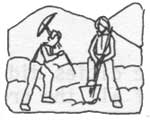|
The Clearwater Story: A History of the Clearwater National Forest |

|

Chapter 23
Emergency Work Programs
The great economic depression started in 1929. At first it was not considered serious. People generally had some reserves, and it was hoped and believed that economic conditions would soon recover. As time passed conditions worsened, so in 1933 a number of federal work programs were started to give people work and to spur the economy.
To put the nation's unemployed young men to work, the Civilian Conservation Corps (CCC) was created by Congress in 1933. This program was for youth from 17 to 21, inclusive. Its operation was divided between the Army and the various conservation agencies. The Army was in charge of subsistance, housing, pay and discipline. The Forest Service was in charge of the work projects done by the camps assigned to it. Men were housed in roughly constructed, barracks-type camps of 200 men, but spike camps were permissible. During the winter months the camps moved to Forest Service Regions 3, 4 and 5.
The first camp established on the Clearwater Forest was at the Bungalow. Later a camp was established at Cold Springs. Blayne Snyder was the Camp Superintendent. There were other camps outside the Forest at Browns Creek, Hildebrand, Pierce, Bertha Hill and Camp 6.
These men could be employed on any type of conservation work. On the Clearwater they were used on blister rust control (BRC), road construction and firefighting. These boys did a lot of work, but the Forest Service used other funds to augment the work. Allotments for CCC work were mostly for salaries. This severely limited the amount of machinery that could be used and the amount of building material that could be purchased. Fortunately the Forest Service had money alloted to it called FRD or Forest Road Development. NIRA funds, which will be explained later, were also used for projects other than roads. By using these funds to purchase and operate machinery and by combining these machines with the hand labor of the CCC, things went along smoothly and efficiently. As the years passed Congress curtailed the FRD appropriations and it became harder to do any work that wasn't almost entirely hand labor. The BRC work fit the CCC program better than any other type of work.
The CCC came to an end when World War II occupied the nation and the young men were inducted into the armed services.
There were other Emergency Work Programs during the depression. One of these was NIRA or National Industry Recovery Act. This money was primarily used to build lookout buildings, telephone lines and ranger stations. A lot of people were involved in this type of work. It came to an end when the Supreme Court declared the Act unconstitutional.
There was another emergency program called the WPA or Works Progress Administration. The Forest Service did not get involved in much of this. It was for cities and towns. It was limited to hand labor and the cities did not have enough other money to go with it to make it effective. Of all the programs, this one accomplished the least. It was often referred to as a leaf raking program.

|
| Civilian Conservation Corps camp at Bungalow in the 1930's. |
| <<< Previous | <<< Contents>>> | Next >>> |
|
clearwater/story/chap23.htm Last Updated: 29-Feb-2012 |